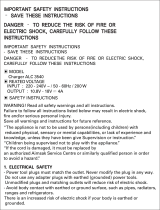6
RBRC Battery Recycling Seals
CHARGER OPERATION
WARNING
Charge only MILWAUKEE
®
M18™
Lithium-Ion batteries in this
MILWAUKEE
®
Lithium-Ion charger. Other types of
batteries may cause personal injury and damage.
When to Charge the Battery Pack
Remove the battery pack from the tool for charging
when convenient for you and your job. MILWAUKEE
®
batteries do not develop a "memory" when charged
after only a partial discharge. It is not necessary to
run down the battery pack before placing it on the
charger.
Use the Fuel Gauge to determine when to charge
your MILWAUKEE
®
Lithium-Ion battery pack.
You can "Top-Off" your battery pack's charge before
starting a big job or long day of use.
The RBRC™ Battery Recycling Seals (see
"Symbology") on your tool battery packs indicate that
MILWAUKEE
®
has arranged for the recycling of that
battery pack with the Rechargeable Battery
Recycling Corporation (RBRC). At the end of your
battery pack's useful life, return the battery pack to a
MILWAUKEE
®
Branch Office/Service Centre or the
participating retailer nearest you. For more
information, visit the RBRC web site at www.rbrc.org.
The only time it is necessary to charge the
MILWAUKEE
®
Lithium-Ion battery pack is when the
battery pack has reached the end of its charge. To
signal the end of charge, power to the tool will drop
making a cut, drilling a hole, or driving a fastener.
Charge the battery pack as needed.
How to Charge the Battery Pack
When a battery pack is inserted into the charger,
the LEDs will indicate the following:
Continuous red: Charging
Continuous green light: Charging is complete
Flashing red: Battery is too hot/cold
Charging will begin when battery reaches
correct charging temperature
Flashing red/green: Damaged or faulty battery
pack
A fully discharged battery pack with an internal
temperature in the normal range will charge in about
30 to 170 minutes, depending on the battery pack.
Heavily cycled batteries may take longer to charge
completely.
The Fuel Gauge lights on the battery pack are
displayed as the pack is being charged, indicating
how fully charged the pack is. The fuel gauge will
turn off when charging is complete.
After charging is complete, the continuous green
light will come on.
The charger will keep the battery pack fully charged
if it is left on the charger.
The second pack inserted in the charger will be-
charged.
Plug the light into a 220-240V outlet. The battery
packs will not charge if the Site Light Charger is not
plugged in. Align the battery pack with the bay and
slide the battery pack into the charger as far as
possible.
MAINTENANCE
WARNING
To reduce the risk of injury, always
unplug the tool and charger and
remove the battery pack from the charger or tool
before performing any maintenance. Never disas-
semble the tool, battery pack or charger. Contact
a MILWAUKEE
®
service facility for ALL repairs.
Maintain Light
Keep your light, battery pack and charger in good
repair by adopting a regular maintenance program.
If the light does not work properly, return the light to
a MILWAUKEE
®
service facility for repairs.
WARNING
This device contains a
lithium button/coin cell
battery. A new or used battery can
cause severe internal burns and lead
to death in as little as 2 hours if swal-
lowed or enters the body. Always secure the
battery cover. If it does not close securely, stop
using the device, remove the batteries, and keep
it away from children. If you think batteries may
have been swallowed or entered the body, seek
immediate medical attention.
Internal Battery
An internal battery is used to facilitate full ONE-KEY™
functionality.
To replace the battery:
1.
2. Open the battery bay. Twist the cap located in the
battery bay a quarter turn.
3. Remove the old battery. WARNING! Always
keep batteries away from children and dispose of
properly; new and used batteries can cause injury.
4. Insert the new battery (Cat. No. 50-11-0025).
Always use MILWAUKEE
®
replacement batteries;
others may not be rated for high temperatures.
5. Replace the cap and close the battery bay.
WARNING
To reduce the risk of personal in-
jury and damage, never immerse
your tool, battery pack or charger in liquid or
Cleaning
Clean dust and debris from vents. Keep handles
clean, dry and free of oil or grease. Use only mild
soap and a damp cloth to clean, since certain clean-
ing agents and solvents are harmful to plastics and
other insulated parts. Do not use sprays or solvents.
Some of these include gasoline, turpentine, lacquer
thinner, paint thinner, chlorinated cleaning solvents,
ammonia and household detergents containing am-
around tools.
ACCESSORIES
WARNING
Use only recommended accesso-
ries. Others may be hazardous.
For a complete listing of accessories, go online to
www.milwaukeetools.com.au /
www.milwaukeetools.co.nz or contact a distributor.
WARNING
Remove the battery pack(s) and AC cord
connections.
The light source contained in this
luminaire shall only be replaced by
the manufacturer or his service agent or a similar
qualified person.












